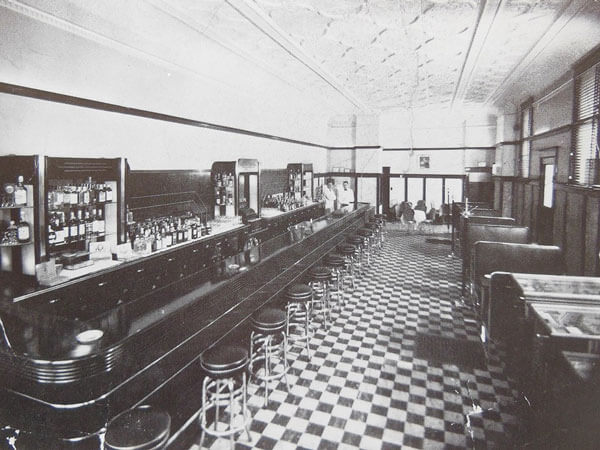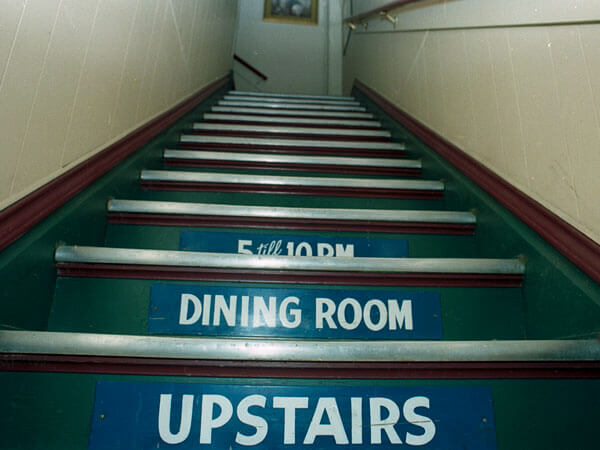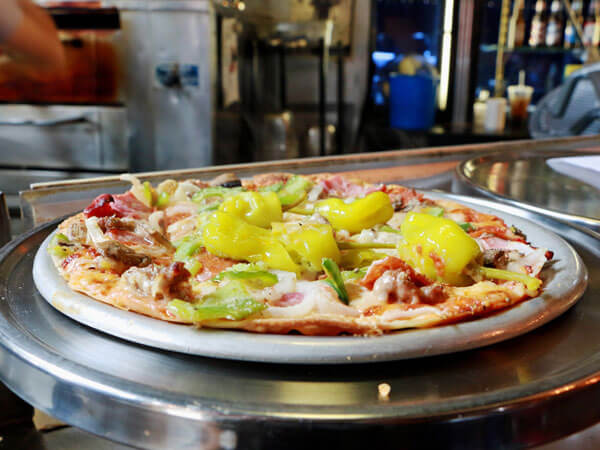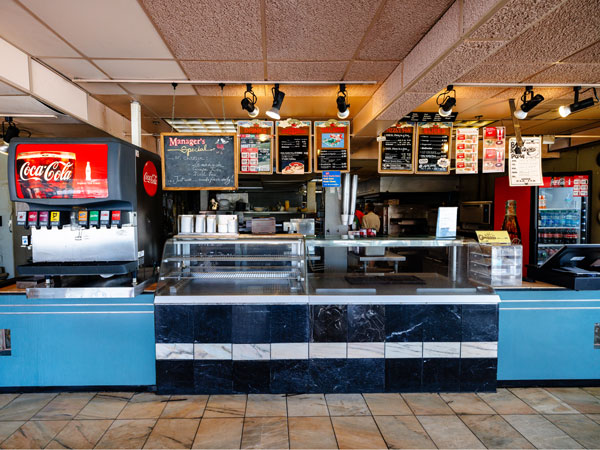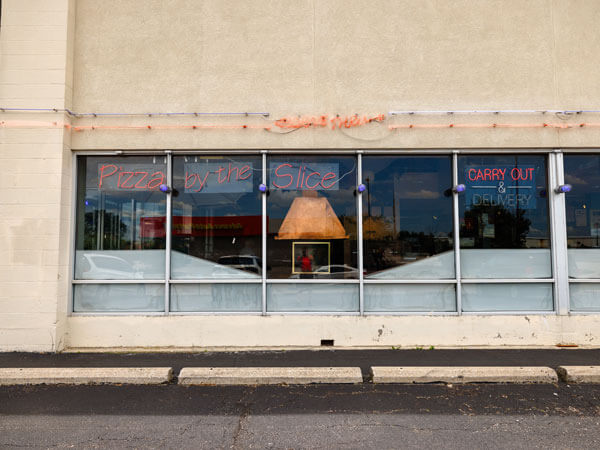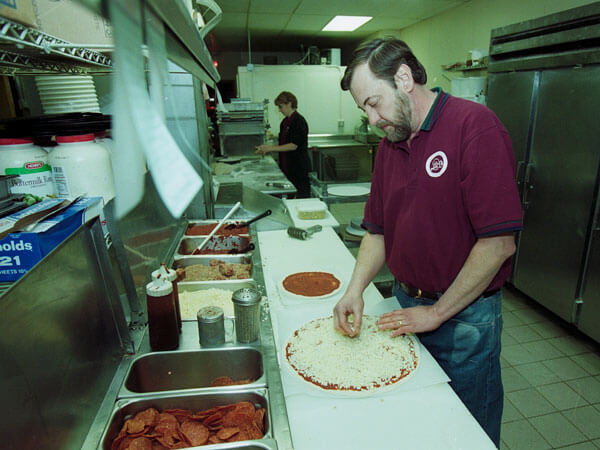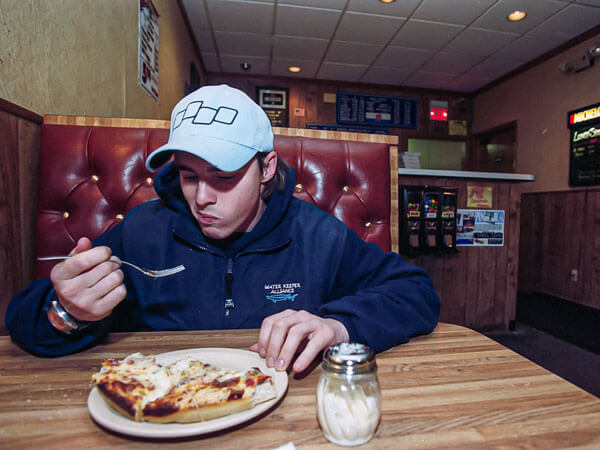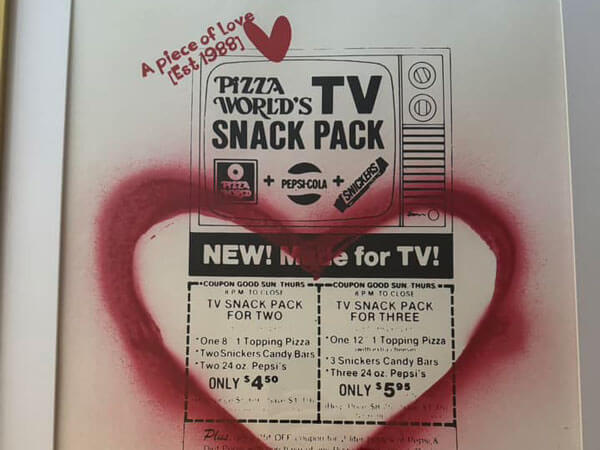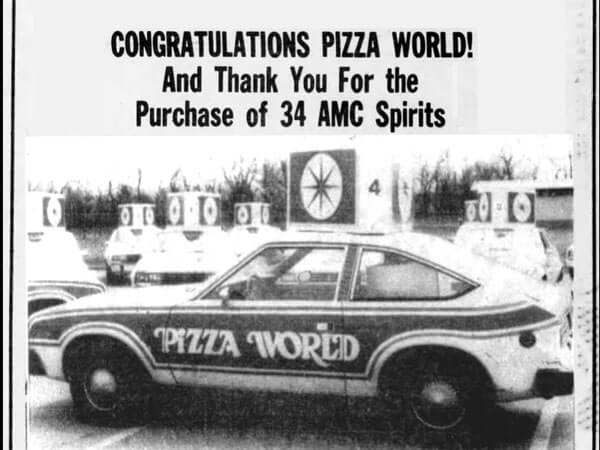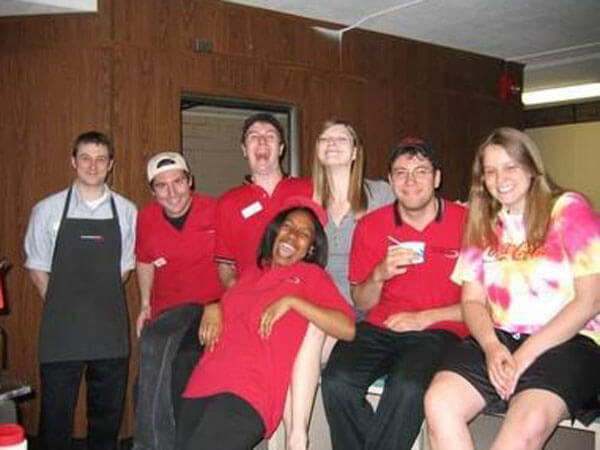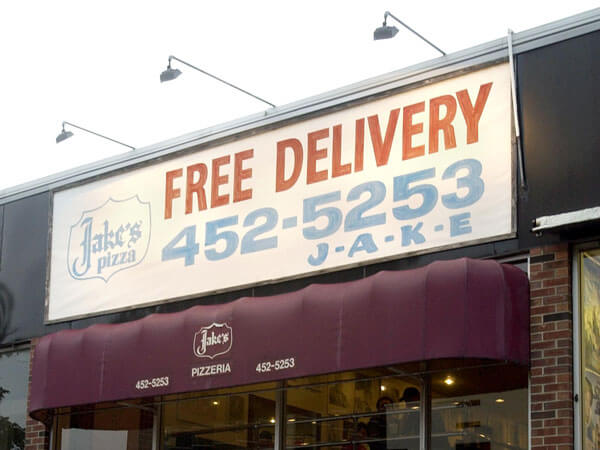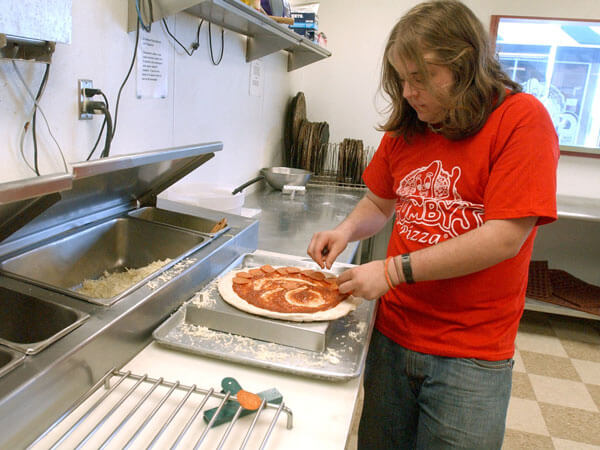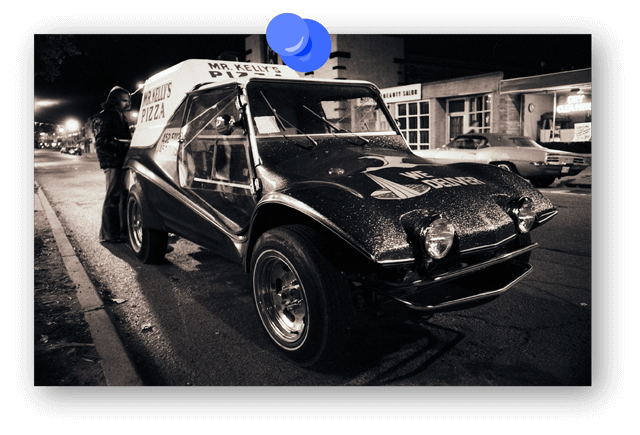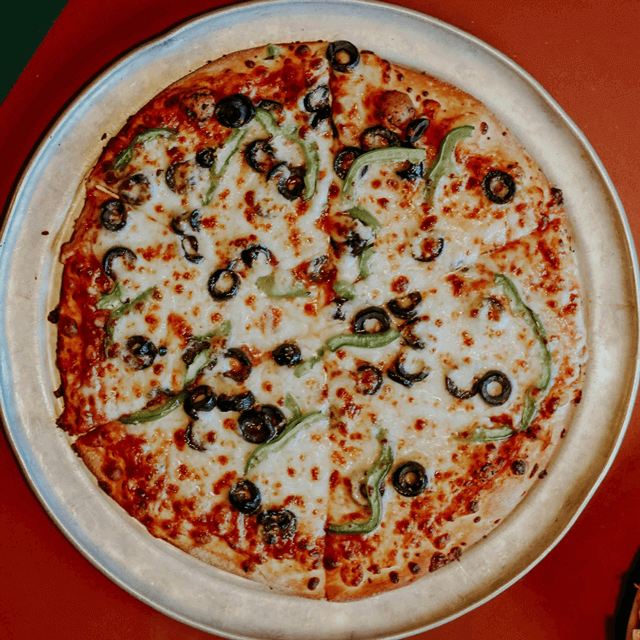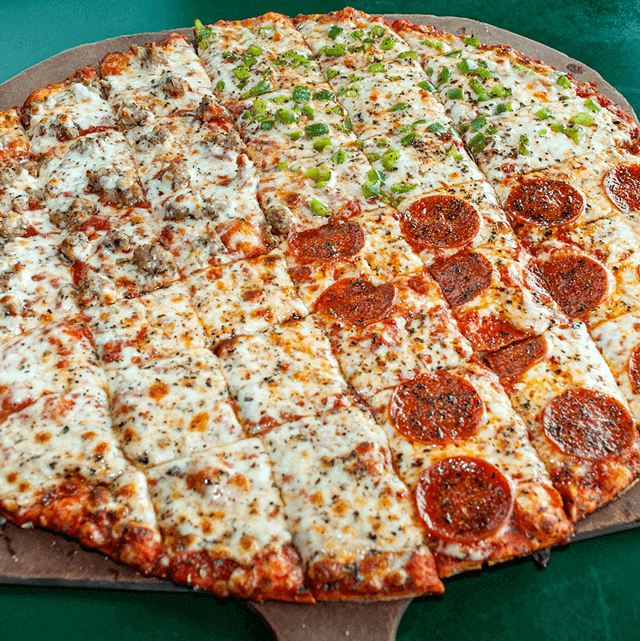The first bite
John and Fred Baldini, children of immigrant parents from Lucca, Italy, brought pizza, a little-known novelty in America at the time, to town in 1936 when they opened Lucca Grill in Downtown Bloomington. A 1953 Vidette ad touted Lucca’s “choice steaks, Italian pizza, and spaghetti.”
Takeout options, such as Casella’s Pizza Palace, opened near campus in the mid-1950s. A 1955 Vidette article introducing Homecoming court nominee Mary Broomfield ’56 contained the paper’s first account of a college student enjoying pizza under the headline “Mary Likes Pizza.” Another Vidette story in 1957 described “a pizza party and dancing” at Smith Hall.


Charles “Tot” Baldini, son of Lucca Grill co-founder Fred Baldini

Newspaper feature
Vidette extras



Ralph Senn, co-owner Garcia’s Pizza in a Pan


Normal twist on Chicago flavor
“My check register was: Micheleo’s, Micheleo’s, Micheleo’s, Kroger,” said Mick Hall ’89. “Those were priorities in the ’80s.”
As the food manager and treasurer for his fraternity, John Narish ’93 took full advantage of a Micheleo’s Sunday evening deal. “I looked at what the regular meal was going to cost versus taking the house to the pizza place,” Narish said. His favorite was cheese, sausage, and extra sauce. “Micheleo’s was far cheaper than the cost of feeding the guys through our service. Everyone loved it, and I was a hero.”
By the late-1980s, more than 25 pizza places served Bloomington-Normal. The list included Chicago Dough Company and Papa John’s, which was unrelated to the national franchise and located in a “small shack at the corner of Willow and Normal,” according to the Vidette.
Pizza World, which originated in Normal in 1970 and became a small franchise, was another student favorite. In 1979, the company paraded its fleet of 34 red and white AMC Spirit delivery cars through campus, and across Central Illinois, to mark its rise in the world of pizza.

Micheleo’s Pizza founders Mike and Geri Koch



When Verneice Prince ’17, M.S.W. ’20, and her son arrived at his school, she’d open the trunk of her car, pull out a loaf of bread, and prepare his lunch: a beef bologna sandwich. They were homeless, living in a Detroit shelter where residents weren’t allowed to bring in food.
One night she asked if she could put his food in the shelter refrigerator and was told she could not. There were words, and Prince and her son were put out on the street that night. Seven months pregnant, with no money and a car that wouldn’t start, she and her son started walking until she couldn’t go any farther and laid down on the sidewalk. A police car slowed and pulled over. Her son thought they were in trouble, but Prince knew differently. Now they’d have a ride to another shelter.
Appears InFor the first 20 years of her life, Prince grew up in foster care, keeping her clothes in trash bags because she never felt secure enough to put them anywhere else. She never had a birthday cake, a sleepover, or a family vacation.
“There was no childhood for me,” she said. “I know what it is like to have needs but no one to call on to help meet those needs.”
In 2017, the single mother of four earned a bachelor’s degree in social work from Illinois State University, and in 2020, her master’s. At 51, she is the CEO of a nonprofit she founded in 2018 to help people facing homelessness, Cruisin’ Outta Poverty Services.

“If I can help one person, whether it is the children I work with or clients that come through, I would feel like I took back what was taken from me in my childhood.”
—Verneice Prince ’17, M.S.W. ’20
Prince provides an umbrella of services for those seeking emergency shelter, transportation, clothing, and food. She will enroll and tutor those interested in GED classes, has provided an address for job applicants, and temporarily cared for pets. As a counselor, mentor, and navigator, she moves people from homelessness to hope.
On the door of the nonprofit’s storefront in an outlet mall in Normal is a handwritten sign that reads, “If we are not here, we are serving the community.”
“We answer the call when someone is in need of help that they cannot get anywhere else,” she said, sitting in the back room she’s turned into a kitchen for those needing a place to sit, talk, or warm a meal. “This is where I want to be.”
Prince meets people where they are, and sometimes that’s standing outside their tent in a parking lot encampment. She understands not wanting help or not wanting to be seen. She’s been there.
“If I come to you and I haven’t showered, my clothes are soiled, I don’t want to be in front of you. I can’t come to you for help because I’m not in any condition to,” she said. “Once we get their basic needs met, we take it from there.”
Homelessness is a growing issue in McLean County, where 15.7% of the population lived in poverty in 2021, rising from 14.2% in 2016, according to data from the McLean County Regional Planning Commission. In 2023, there were 1,249 homeless adults and children.
When local shelters are full, Prince has driven people to a shelter 40 miles away. Last winter she shared her home with three people who had nowhere else to go.
Prince entered the foster care system when she was only a year old and was shuffled to so many families she has forgotten their names. She gave up hope of finding anyone to call mom or dad. Her goal was to survive childhood.
Aging out of the system at 20, she joined the United States Army, where she qualified as a truck driver only because a friend gave her a few driving lessons in a parking lot. The Army is where her education began when she took a college course. She always wanted to be a social worker.

After two years in the Army, Prince was honorably discharged as a disabled veteran. But homelessness followed her through two marriages and four children as she moved around, staying with family who didn’t feel like family. In 2013, she moved to Bloomington and lived at Home Sweet Home Ministries with her three youngest children.
Wherever she was, she found a church and called on her faith when hope waned. One Sunday she saw a church van in the shelter parking lot and climbed in. After the service, she met the pastor’s wife, Dr. Karen Stipp, who happened to be an associate professor in Illinois State’s School of Social Work. Prince shared her dream of becoming a social worker, and Stipp became her encourager.
“She said she was going to be my cheerleader, and I didn’t know what a cheerleader was,” Prince said. “But she showed me.”
The School of Social Work has had students who experienced homelessness and food insecurity, Stipp said, “but the confluence of factors in Verneice was unique. She had little margin for error. Her student days—like her life—were about surviving while thriving.”
Prince works part time as a counselor at the Bloomington nonprofit INtegRIty Counseling and supplements her income as a substitute teacher and Uber driver. Whatever money is left over at the end of the month goes to her nonprofit.
A year ago, she wrote on Cruisin’ Outta Poverty Services’ Facebook page that she was facing some hard times of her own, feeling like she was still trying to escape poverty. She asked people to donate $1 to the nonprofit. Some did, but not enough.
—Dr. Karen Stipp
“It takes a group of people to move the needle, and she’s one of the people who’s doing that in just incredible ways. With her faith and determination, she makes it happen every day.”
Prince has received grants and donations and hopes to someday have an overnight shelter. She has the beginnings of a food pantry, but only enough rice, pasta, cereal, and vegetables to fill two grocery bags. A small refrigerator holds homemade meals.
Every day she’s on her feet, sorting and organizing donations for the thrift store she opened next door. The disabled veteran doesn’t stop until she must. She keeps crutches and a walker close by but keeps the fear of returning to homelessness further away.
“Whatever I have to do to keep things going and be able to help people, that’s what I do,” she said. “I think I’ve finally let go of the fear of being homeless, but I know that it can happen.”
Stipp has had a decade-long relationship with Prince and sees her as a resilient and resourceful leader.
“One person can’t take on poverty all by themselves,” she said. “It takes a group of people to move the needle, and she’s one of the people who’s doing that in just incredible ways. With her faith and determination, she makes it happen every day.”
Prince is not only looking to change the stories of homeless people but also her own.
“I love what I do, and I will be here until I am not,” she said. “If I can help one person, whether it is the children I work with or clients that come through, I would feel like I took back what was taken from me in my childhood.”
When Rick Valentin was a young college musician and had an opening for a bass player, he turned to Rose Marshack. There was only one problem: Marshack had never played bass.
“His bass players kept quitting,” Marshack said. “He didn’t know he needed me as his bass player.”
Appears InThe choice was between Marshack and a guy named Pete. “But Rose had perfect pitch, and she was into punk rock,” Valentin said. “Obviously, she was the right choice.”
Marshack and Valentin have been bandmates for 38 years, married for 28 years, and Illinois State University faculty members in the School of Creative Technologies (CTK) together for more than a decade (Marshack was hired in 2007, Valentin in 2009). Both are CTK professors. Marshack is the school’s interim director.
The parents of two sons, Gram and Dao, they still play music together—just not as often as they once did.

Their journey began when they met as undergrads in their dormitory at the University of Illinois at Urbana-Champaign. Their band, Poster Children, played dorms and house parties on campus and later opened for bigger punk bands. They were a touring band for over a decade. The years rolled by, and the shows piled up. Poster Children has played over 800 dates in the U.S. and Europe and released 10 albums. They’ve had music videos on MTV and been featured in wide-ranging media, from The New York Times to the Cartoon Network.
As computer science majors, they knew a lot about technology. They designed their own album covers and were early adopters of new technologies. They posted blogs and podcasts on the internet long before those terms were part of our lexicon. It was a way to connect with their growing fan base. They published their first podcast in 1999, although that’s not what it was called back then.
“We knew that we could create an audio file, and we knew that we could put it on the internet so anyone could access it,” Valentin said. “And then we started just the two of us doing a recorded kind of chat and putting that up.”
Marshack wrote about the band’s history and her experience in it in Play Like a Man: My Life in Poster Children, published last year. It chronicled the band’s do-it-yourself (DIY) ethic: writing original music, booking its own shows, selling T-shirts, driving a van all over the country, and sleeping on the floors in the houses and apartments of fellow musicians in the cities they played. (They reciprocated the hospitality when musician friends came to play in Central Illinois.)
Play Like a Man also documents the band’s innovative ways and DIY approach to technology. Skills honed by Marshack and Valentin from their experiences playing in Poster Children have served them well as professors in CTK, where they infuse their teaching with the same innovative spirit they’ve brought to their band.
—Rose Marshack
“We teach students that community is important, and that they’re a community of students.”
Valentin remembers feeling out of place as a tech-savvy musician back in the 1980s, but his students today embrace the identity. “Now it seems pretty normal to be kind of a creative, techie person, but it was unusual then,” he said. “Now more people have seen the value of that mix of creative work and how technology can be creative.”
But other lessons learned from the road permeate their teaching, too. They try to build the same community in the classroom that they have felt as a community of musicians.
“We teach students that community is important, and that they’re a community of students,” Marshack said. “I tell them in the middle of class when I’m teaching, ‘OK, take a break now and see if the person next to you is caught up. I want you to make sure that they know exactly what’s going on in the class.’
“Because we’re all in this together. Once you leave here, you’re going to be working with other people. You need to learn to take care of them.”
Valentin said CTK offers a collaborative environment to help students thrive. It’s by design.
“We want the modern or future student to be able to ride the waves of technology and changes and still be able to be relevant and do good work,” he said. “Because of their skills, a lot of times they become the sort of connectors in situations where the engineers can’t talk to the creatives. So, they can be the person who is trying to get everybody to understand each other. That’s a really valuable job and skill.
“You can call it networking, or you can call it community. And that’s where we came from. And I think that’s typical of musicians.”
CTK is growing at Illinois State—it grew from a program to the School of Creative Technologies in 2023—and Marshack and Valentin have played no small part. But they haven’t done it alone. Marshack praised her predecessor, Aaron Paolucci, for his leadership, program creator Dave Williams for his vision, and advisor Jody Decremer for building relationships—and community—with students.
“I’m just thrilled to be the caretaker. We’re a really tight-knit group of professors who really respect—I could even say love each other,” she said. “I’m thrilled that Rick is also part of it. These people are my heroes.”
Marshack recalls being impressed by the personal touch at Illinois State during the interview process. “The faculty were talking about students by name, and I was like, ‘You know their names!?’” she said. “I thought: ‘I’m home. I want to be here.’”
She still feels that way about her colleagues, describing them as “extra generous and extra caring.”
At her first winter commencement at Illinois State some years ago, Marshack was seated next to a faculty member from another department. She was curious about his experience.
“I poked him, and I was like, ‘Dude, my group of people, my faculty that I get to work with, I love them. Is it like that where you are too?’” Marshack recalled. “And he goes, ‘Yeah, just like that.’
“And I just thought, ‘Wow, what a great place.’”
Steve Pankow ’11 stands in the entryway to the Chicago Bulls equipment room deep inside the United Center holding a Nike Zoom Kobe 4 “Fade to Black” basketball shoe. There’s a five-inch gash above the shoe’s hard rubber midsole that Pankow wiggles four fingers through as part of an equipment manager’s postmortem examination.
Appears InLess than 24 hours earlier, the shoe was in fine working condition. It was on the left foot of Bulls guard Alex Caruso, who had helped engineer what was about to be a stunning upset of the Western Conference-leading Minnesota Timberwolves. But late in the game as Caruso and company were putting the finishing touches on the win, the 2023 NBA All-Defensive First Team selection jumped to contest a shot from Minnesota all-star Anthony Edwards. Caruso landed awkwardly as the shoe exploded.
Pankow was among the first to realize what had happened. He sprang into action, sprinting 40 yards to the locker room to retrieve a backup pair of shoes.
“When something like that happens, it’s an adrenaline rush,” Pankow said. “Whether it’s blood on a jersey or a blown-out shoe, that’s what we prepare for, and that’s what gets me cranked up.”
Amid a late-season playoff push, Caruso couldn’t wait even the few seconds Pankow needed for the retrieval, instead finishing out the game wearing teammate Dalen Terry’s Adidas models. The Bulls won the game, 109-101.
Pankow recounts it all the next day at the mouth of the equipment room as the Bulls prepare for a game against the Atlanta Hawks that’s still a couple hours from tipoff. Bulls players and personnel coming from every direction squeeze past Pankow as they complete their pregame routines. Eventually Caruso arrives, puts his arm around Pankow, and laments the demise of his favorite pair of shoes.
Pankow is the Bulls’ head equipment manager and team travel coordinator. At 6-foot-4, he’s as tall as some players but skinnier than all of them. A Sharpie marker clipped to the collar of his team-issued polo serves as his trademark piece of flair, indicating to fans who surround the team bus when the Bulls arrive in another NBA city or kids who line the tunnel when the team takes the court that Pankow is not one they’ll see on the court that night.
He doesn’t play for the team, but he’s an integral part of it.
Pankow got his start in sports at Illinois State University after sending an email to then-head football coach Denver Johnson the summer before his freshman year asking Johnson if there was anything he could do for the team. That led to four years as a student manager, internships with the NFL’s Green Bay Packers and Indianapolis Colts, and a job with Navy athletics before a full-circle moment when he returned to Illinois State as a full-time equipment manager.
Now in his “dream job,” Pankow travels full time with the Bulls, sits behind the bench, and loves every minute of it. He’s one of at least eight Illinois State alumni working full time for the NBA team. Though none of them are scoring points or dishing out assists, they form the team behind the team. Several of them got their starts in sports at Illinois State.
“It’s different every day,” Pankow said. “That’s the part I love about it, and that’s what I think most people love about it.”









Owen Ritter ’24 is a budding branch on a family tree with deep Redbird roots.
Appears InRitter graduated from Illinois State University in May exactly 50 years after his grandfather Bill Arbogast ’74, and 101 years after his great-great grandfather Chester M. Hammerlund, class of 1923. And they’re just three from a family that’s produced at least one graduate every decade since the 1890s. Ritter’s mother and many cousins, aunts, and uncles have also graduated from Illinois State.
“Pretty much everyone went to ISU, so I can talk about and connect with all of them about my time in college,” Ritter said. “I was brought to all the Homecomings, and we went to a lot of games. I still remember when Jackie Carmichael hit a game-winning 3-pointer when I was a ball boy.”
Such memories are shared when the family gathers, and Arbogast has many. He’s still making them.
“I love the Bloomington-Normal area,” he said. “It’s nice living in town and still being able to take advantage of the opportunities the University has to offer.”
Arbogast’s “Redbird family” extends even beyond biological connections.
“Living in the dorms, I gained 30 brothers all of a sudden,” said the former Manchester Hall resident. “I think ISU does a great job of making campus feel like home to people who don’t have a legacy here, who didn’t grow up in town.”
The grandfather and grandson exchange stories regularly, and that continued at Ritter’s graduation and pinning ceremonies when he earned a bachelor’s degree in nursing in May. Arbogast and other family members were in attendance.
Ritter may be leaving the nest and spreading his Redbird wings, but he’s certain he’ll return to reminisce and create more memories, just like his Redbird relatives before him.
Biology major Danielle Edwards is using wide-ranging skills to make an impact on the health of the Bloomington-Normal community even before she enrolls in medical school.
Appears InEdwards can often be found at the Community Health Care Clinic, a free clinic in Normal for people who are underinsured, where she works as a translator for Spanish-speaking patients. The opportunity allows Edwards to practice her Spanish and use her medical knowledge to educate patients about their ailments and the recommended treatments.
Edwards also volunteers and serves on the board of the School Street Food Pantry, which provides free food and personal care items to currently enrolled college and trade school students in Bloomington-Normal.
The experiences have been instrumental to Edwards’ education and future career in the medical field, but she wouldn’t be able to pursue them without scholarship support. Edwards received the Judge Russell DeBow Scholarship, named in honor of the late Judge Russell DeBow ’35. The support lessened Edwards’ financial challenges and associated stress and allowed her to make an impact in the community.
“If I didn’t have scholarship support, I’d have to spend less time getting involved in the campus community, which would mean spending less time volunteering,” she said.
Edwards has her sights set on medical school, and after that, she wants to make the medical field more accessible and less threatening for those in the Black community.
“I am excited to pursue a career in medicine to alleviate the unease between Black and brown individuals and doctors, while also increasing their access to medicine,” said Edwards. “Because of historic cases, such as Henrietta Lack and the Tuskegee Experiment, medical distrust among the Black community has grown.
“My hope is that by serving as a Black doctor, I can relate to my Black patients and their fears, while creating a safe space to help manage their illnesses as a team.”
Scholarship support makes it possible for students like Edwards to go above and beyond during their college careers. To learn more about creating a scholarship or to give to a current scholarship fund, visit Giving.IllinoisState.edu.
Milner Library is now accepting applications for the 2024 Dr. Thomas D. Wilson Student Assistant Scholarship. This scholarship is a one-time award of $1,000 given to two student employees who have worked at the library for at least one semester.
The award was created in 2020 by Kay Wilson in honor of her late husband, Dr. Thomas D. Wilson ’59, who supported Milner Library and loved to learn. Thomas Wilson taught politics and government at Illinois State from 1961 to 1992. He was a member of the Friends of Milner Library Board for multiple years, even serving as president. Thomas Wilson also enjoyed helping with the annual book sale that used to be held at the library. He worked to help collect and sort more than 10,000 books sold to raise money to fund grants for special projects and speakers.
Other eligibility requirements for the award include at least a 3.0 GPA, and applicants must be a sophomore, junior, or senior who will be enrolled for classes in spring 2024. Interested library student assistants should complete all application materials and should submit materials no later than Friday, September 27, at 11:55 p.m. Applications will be evaluated based on clarity of writing; thoughtful reflection on daily work and other library activities; narrative of holistic experience at Milner Library both positive and challenging; and demonstrated application of skills learned at Milner Library to their major courses or other areas of their lives.
Any questions can be directed to the Milner Library Director of Marketing and Communications Michelle Neuffer by email at mgneuff@IllinoisState.edu or by phone at (309) 438-3897.
Earlier this month, the Illinois State University Board of Trustees approved the naming of the CORE Construction Laboratory, located at 604 N. Adelaide St. in Normal. The designation recognizes CORE Construction’s generous commitment to supporting the University’s construction management facilities.
The CORE Construction Laboratory will feature a state-of-the-art laboratory space for construction management students and supports rapid growth within the major.
“CORE Construction has long been a valued partner to Illinois State,” said Dr. Aondover Tarhule, Illinois State University president. “From scholarship support for students in the construction management program, to championing Redbird Athletics and employing our graduates, CORE Construction continues to elevate the Illinois State University experience.”
During the development of Illinois State’s Science Laboratory in the mid-1990s, Jim Jacobs, now CORE Construction’s Chief Executive Officer, worked closely with the late Chemistry professor, Dr. Sol Shulman. Jacobs admired Shulman’s servant leadership, and the values Shulman embodied—humility, trust, and transparency. Today, these values remain guiding principles for CORE Construction under Jacobs’ leadership.
“CORE is honored to work with Illinois State University on projects that positively impact their growing campus. An even greater honor is having built such a strong relationship with the entire ISU community,” said Tim Erickson, president, CORE Midwest. “We are so excited about the addition of the Construction Laboratory as a way to provide students the opportunity to explore and pursue career opportunities in construction and impact our industry.”
Over the years, CORE Construction’s craftmanship and professionalism have enhanced Illinois State University’s facilities and programs. CORE executed the 2017 Bone Student Center revitalization and more recently, the Center for the Visual Arts Rotunda redesign.
The company also recruits from Illinois State’s talent pool through annual participation in the construction management career fair. Two alumni, Todd Steffen ’99 and Tim Bassett ’09, hold regional president roles.
“CORE Construction’s commitment to Illinois State University exemplifies the strength of our partnership and underscores the company’s investment in our shared mission and values,” said Vice President for University Advancement Pat Vickerman. “This collaboration not only fuels economic growth but also elevates educational excellence, creating a lasting impact on the University and the communities our graduates will empower.”
Corporate and foundation supporters contribute to the vitality of Illinois State University. To invest in the Illinois State experience as a corporation, organization, or foundation, contact Joni Staley, director of corporate and foundation philanthropy at (309) 438-7735 or jstale2@IllinoisState.edu.
Homecoming 2024: Relive the Moments is set for September 23-29, culminating with Redbird Football against North Dakota State on Saturday, September 28, at 2 p.m., at Hancock Stadium. Tickets, as well as tailgate and parking passes, are available at GoRedbirds.com.
Visit Illinois State’s Homecoming page for a full schedule of events.
Highlights of the week are below. All events are free and open to the public unless a fee is noted.
Sunday, September 22
Reggie Day at the Zoo canceled because of weather conditions.
Monday, September 23
NEW this year! Homecoming officially begins with a combo of two of our favorite events—the Kickoff and the Tree Lighting. Join us from 6-7:30 p.m., in Uptown Normal. Celebrate alongside President Aondover Tarhule and Normal Mayor Chris Koos as they light the trees with red and white lights. Enjoy inflatables, Papa John’s pizza, games, giveaways, entertainment, and Redbird pride. The first 500 Illinois State students to show student ID will also receive a free Homecoming T-shirt.
Tuesday, September 24
Get your tickets for the Peach Pit concert at 7 p.m., in Braden Auditorium. Peach Pit is an indie pop quartet from Vancouver featuring Neil Smith, Chris Vanderkooy, Peter Wilton, and Mikey Pascuzzi. The group formed in high school, and their first single “Peach Pit,” racked up 78 million streams on Spotify in 2016. Normal native and American Idol finalist Leah Marlene will open the show.
Tickets are $30 and $20 at Ticketmaster.com or at the Braden Box Office, located in the Bone Student Center.
Wednesday, September 25
Give the gift of life at the Redbirds Care Homecoming Blood Drive from 11 a.m.-3 p.m., in the Circus Room of the Bone Student Center. Registration is available at Homecoming.IllinoisState.edu.
Thursday, September 26
The Black Colleagues Association will hold a Virtual Scholarship Celebration at 6 p.m. (CST), via Zoom. Register by September 25 online.
Friday, September 27
Homecoming kicks into high gear with celebrations across campus. Start the morning learning about the achievements and big moments of Redbird alumni honorees at the Alumni Day Luncheon at 11:30 a.m. Cost is $25. Register by emailing Juliana Nelson at jedunca@IllinoisState.edu or (309) 438-2495. Deadline is September 18.
Cheer for Illinois State volleyball at 6 p.m. in CEFCU Arena when they take on Murray State. In between the second and third match, see the crowning of this year’s Reggie’s marshals. Get tickets at the door or before the games at GoRedbirds.com/Tickets.
End the night at the Black Colleagues Association “Club 4.0” from 7 p.m. to midnight, Holiday Inn Bloomington-Normal. Step tutorials, food, dancing all set for Redbirds. Register online by September 20.
Saturday, September 28
The Hybrid Town and Gown 5K/1-Mile Fun Run/Walk begins at 8 a.m. at the Student Fitness Center for those taking part in person. Virtual runners can begin wherever they choose. Registration is required.
The celebration continues with the annual Illinois State Homecoming Parade, stepping off at the corner of College Avenue and University Street at 10 a.m. Those who cannot make the parade can watch it live via the University’s YouTube channel.
Alumni, family, and friends are invited for free food, giveaways, and Redbird spirit at Redbird Village 11 a.m.-2 p.m. in Horton Field House. The Black Alumni Tailgate and the Latinx Alumni Tailgate will be taking place as well in Lot U91 and Lot G53 respectively.
After enjoying tailgating, get ready to cheer for the Redbirds as Illinois State takes on North Dakota State at 2 p.m. at Hancock Stadium. Tickets are available at GoRedbirds.com.
Catch another match when the Redbird’s volleyball team takes on Belmont at 7 p.m. at CEFCU Arena. Get your tickets at the door or before the games at GoRedbirds.com/Tickets.
Sunday, September 29
End the week with the Black Colleagues Association Brunch at 10 a.m., at the Holiday Inn Bloomington-Normal. Register online or call Alumni Engagement at (309) 438-2586 by September 20.
Find additional information on the Homecoming webpage.
Homecoming 2024 is reliving the moments and making new ones! Join in the fun, and be a part of one of the longest-standing traditions at Illinois State University. Find several events listed below, and find all others through the Homecoming website or by following Illinois State Homecoming on Instagram.
Window Painting, 10 a.m.-1 p.m., September 22
Organized by Student Alumni Council, the Homecoming Window Painting is a great way to help get Homecoming week started by painting the windows of a local business around campus. All registered student organizations are welcome to participate. Those interested in helping can contact Darion Effinger, graduate assistant for Alumni Engagement.
Homecoming Kickoff and Tree Lighting, 6-7:30 p.m., September 23
Watch the trees light up at dusk in Illinois State red and white with the help of President Aondover Tarhule and Mayor Chris Koos. Games, giveaway, entertainment, and Redbird pride all included. First 500 Illinois State students to show a student ID will also receive a free Homecoming T-shirt.
Homecoming Concert: Peach Pit with show opener Leah Marlene, 7 p.m., September 24
Peach Pit is an indie pop quartet from Vancouver featuring Neil Smith, Chris Vanderkooy, Peter Wilton, and Mikey Pascuzzi. The group formed in high school, and their first single, “Peach Pit,” racked up 78 million streams on Spotify in 2016. Normal native and American Idol finalist Leah Marlene will open the show. Tickets are $30 and $20 at Ticketmaster.com or at the Braden Box Office.
Redbird Rumble, 7-9 p.m., September 24
Get dressed in full red as we get ready for a little friendly Redbird competition. This event allows the opportunity to compete in a variety of fun events and show your Redbird pride. Limited to 40 teams. Learn more about rules and registration.
Redbirds Care Blood Drive, 11 a.m.-3 p.m., September 25
Visit the Circus Room in the Bone Student Center to save a life. The first 30 to donate will receive a Homecoming swag bag. Register for your spot.
Redbird Volleyball’s Shirtember, 6 p.m., September 27
We’re kicking off Homecoming weekend with Redbirds on the court. Come cheer for our Birds when they take on Murray State. To celebrate “Shirtember,” the first 250 students will get a free Redbird T-shirt. Get your tickets at the door or before the game at GoRedbirds.com/Tickets.
Homecoming Parade, 10 a.m., September 28
Registered student organizations and campus units can be a part of the second-longest tradition at Illinois State. Submit parade entries by September 16 online. Find more information on the parade website.

